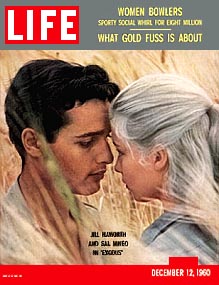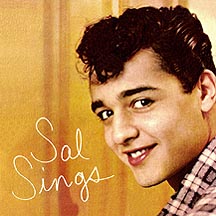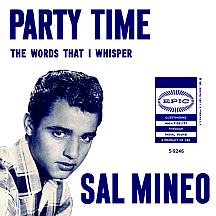SAL MINEO
Start Movin' (In My Direction)
Sal Mineo was a natural performer whose multiple and varied talents couldn't be denied. How many are there who could claim success in theater (an actor and director), films (an award winner), television (a dramatic actor and panel show personality), music (with a top ten hit to his credit) and as an artist's model (on display to this day in one of the leading art museums)? Sal did it all, and his brief foray as a singer was probably the least of his accomplishments.
Born in the Bronx of Italian parentage, he began hanging around with local street gangs and was involved in a robbery when he was ten. His father, Salvatore Mineo Sr., a coffin maker by trade, kept a closer eye on the boy after that as young Sal began taking acting lessons. Opportunities came quickly; his mother took him to auditions and in 1951, just 12 years old, he made his Broadway debut with a minor role in The Rose Tattoo starring future Tony and Oscar winners Maureen Stapleton and Eli Wallach. Later he was featured on Broadway in The King and I and became close friends with the show's star, Yul Brynner. TV producers were impressed with the young actor as well, casting him in two 1952 installments of Hallmark Hall of Fame and other programs.
In 1953, the still relatively unknown actor made an appearance on Jukebox Jury (a.k.a. The Peter Potter Show), a Sunday evening ABC-TV program where a panel of stars would rank the latest records with a "hit" or a "miss" vote; future co-star Natalie Wood was among the many celebrities featured on the show. Sal's movie career got under way in 1955 with a small part in Seven Bridges to Cross with Tony Curtis. Next he made an indelible impression in the James Dean milestone Rebel Without a Cause (also starring the aforementioned Miss Wood), playing a disturbed teenager with an obsessive fixation on Dean's character; his performance earned Sal his first of two Academy Award nominations and the movie's success grabbed the attention of untold millions of mostly-female fans who regularly mobbed him at personal appearances, prompting the press to refer to the whole thing as "Mineo Mania" (within a few months some guy from Mississippi named Elvis wound up inheriting Sal's problem tenfold).
The 1956 film Crime in the Streets had Mineo playing a gang member, resulting in a short-lived nickname for the the actor, "The Switchblade Kid." The standard big studio typecasting had begun and it took Sal awhile to pull away from it; in the meantime he became a major star, particularly among youthful moviegoers. He made regular dramatic TV appearances, starring in at least a dozen teleplays during a two-year span from '55 to '57 while appearing in seven films during the same stretch, including Giant (also with Dean) and Somebody Up There Likes Me. The next step for the teen idol was a no-brainer: Epic Records offered him the chance to be a singing star.
Sal premiered his first single, "Start Movin' (In My Direction)," on NBC's Kraft TV Theater May 1, 1957. He also appeared on ABC's The Big Beat, legendary disc jockey Alan Freed's short-lived rock-centric series, as well as The Perry Como Show, The Steve Allen Show and other small screen venues. "Start Movin'," written by songwriting stalwarts David Hess (as David Hill) and Bobby Stevenson, exposed Mineo's singing voice as a high-pitched, nasally, yet positively energetic force. Billboard magazine made reference to his "boyish delivery" (he was 18 at the time) in reviews. He was not everyone's cup of tea, but the timing was right and it suited the late '50s teen crowd. The song broke in several markets in the spring, going as high as number two in Detroit; by June '57 it was in the national top ten. At this point Sal had been a success at everything he'd attempted.
The single's B side, a spoken ode to romance called "Love Affair," also found its way onto the airwaves. Horrendously delivered, only the sappiest of souls smitten with Sal would find it appealing; it begged the question, "Will he ever be able to follow this with another hit single?" The answer came in September with the top 40 hit "Lasting Love," a romantic ballad, thankfully sung this time (though slightly out of tune). Mineo actually possessed an appealing lower register kept hidden except on a handful of album tracks; his higher-pitched (and occasionally goofy) delivery became the standard for all single releases.
The next two singles were uptempo numbers and each landed mid-chart. "Party Time" was predictably contrived, while the early-'58 "Little Pigeon" is my favorite of all Salsongs: 'Come on little pigeon give me love, love, love...a-we'll be close like a couple-a doves...' set against a thrusting sax riff. Its flip is the delightfully demented "Cuttin' In" ('Back up Buster, take your hands off please...that's my baby that you're tryin' to squeeze...I'm cuttin' in, I'm cuttin in, you're cuttin' out, you're cuttin' out...') Sal's silly, whimsical side easily wins out over his pseudo-serious romantic recordings. Amour was never such a bore! Epic put a concerted effort into promoting the next single, "A Couple of Crazy Kids," but Sal's time as a recording artist had expired just ten months after it had begun...they just didn't know it yet. Epic released nine Mineo singles and one album between 1957 and '59 before moving on to greener pastures.
Juxtaposing Mineo's singing sideline with his more prominent acting career is difficult; at one he was marginal, at the other often brilliant. His star had grown so large, particularly with the younger set, that Bob Hope, appearing on a TV variety show in January 1959, jokingly announced that there would be "No school tomorrow, kids. It's Sal Mineo's birthday. All those in the Bronx can stay home." A record was set for absenteeism in Bronx-area schools the following day. Oops! Hope issued an apology. His Epic contract canceled, Sal nevertheless made an effort to stay connected to music. He learned to play the drums for his starring role in The Gene Krupa Story, which hit theaters in late 1959.
Perhaps his greatest role came the following year with the massive success of Otto Preminger's Exodus. His portrayal of a young survivor of Auschwitz during World War II won him a Golden Globe award for Best Supporting Actor and an Academy Award nomination for same. Chill Wills, a competing Oscar nominee that year (for The Alamo), mounted a shameless campaign (ahead of his time!) to win the award, at one point running a huge trade ad listing every Academy member's name along with a message from Wills: "Win, lose or draw, you're all my cousins and I love you all." Veteran movie star and You Bet Your Life host Groucho Marx ran an ad afterward, stating, "Dear Mr. Chill Wills: I am delighted to be your cousin but I voted for Sal Mineo." Neither Chill nor Sal won; Peter Ustinov nabbed the Oscar for his performance in Spartacus.
Sal continued working in films and television but offers gradually declined in the '60s. He made a couple of mid-decade attempts at rekindling his music career with one-shot releases on the Decca and Fontana labels. A choice he made in 1962, to pose nude for painter Harold Stevenson, may have come across as an affront to the morals to many in the entertainment industry (hard to imagine that) and could be partly responsible for the lack of work. Stevenson's painting, titled "The New Adam" (referred to by Mineo as "Reclining Nude") is a large oil painting on nine separate canvases; all together it measures 8 feet high by 39 feet long. Today the painting is housed in the permanent collection of Manhattan's Guggenheim Museum. One might wonder whether the enthusiasm of identical cousins Patty and Cathy over meeting guest star Sal in the 1965 Patty Duke Show episode Patty Meets a Celebrity had anything to do with their perhaps having seen the provocatively notorious work of art...but alas, the piece had been pulled from a planned exhibition at the Guggenheim in 1962 and it wasn't until the 1990s that the painting was no longer considered too shocking for exhibition.

Actress Jill Haworth was 15 in 1960 when she appeared with Mineo in Exodus, her first film. The two began a relationship that eventually led to an engagement (but not marriage); they were together off and on through most of the decade and at one point in the late '60s she had an abortion...right around the time Sal decided to publicly admit his homosexuality (though under the circumstances bisexuality would likely be the accurate term). Movie roles had almost completely dried up by this time but he made a number of guest appearances on TV dramas (and the occasional sitcom) while feeding his desire for serious acting with stage productions, some self-directed. One such effort was Fortune and Men's Eyes, which played off-Broadway and in Los Angeles. A controversial story set in a prison, it dealt with sexual brutality among inmates. The L.A. production included a young Don Johnson, prior to his first movie role.
Sal's final theatrical film appearance was in Escape From the Planet of the Apes in 1971. After that he juggled his television work with stage productions. On February 12, 1976, he was coming home late at night from a rehearsal of P.S. Your Cat is Dead (he played a burglar in the comedic stage presentation). Outside his West Hollywood apartment, he was stabbed and killed by a transient who was attempting to rob him. Investigators were stumped at first, but in a bizarre coincidence, actress Christa Helm was killed in the same kind of random crime on February 12, 1977...exactly one year later. Lionel Ray Williams was arrested and further investigation linked him to both murders; he was sentenced to prison in 1979 after a lengthy trial. Helm had made only a few film and television appearances; it will never be known whether she had potential for something greater. Sal Mineo, on the other hand, made the most of his 37 years, 25 of them spent in various facets of art and entertainment. His career is one of the most fascinating in the annals of show business.



